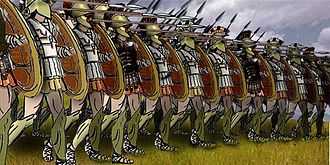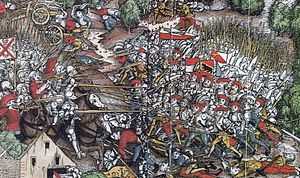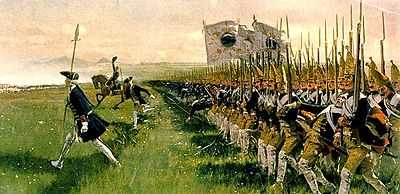Close order formation

A close order formation is a military tactical formation wherein soldiers are close together and regularly arranged for the tactical concentration of force. At about the time of the U.S. Civil War (1861–1865), such combat formations of soldiers became uncommon, when improved small arms and artillery made a death trap of open ground for any formation so exposed. Hence, the technological concentration of much firepower to fewer soldiers rendered the close order formation obsolete by the end of the 19th century.
History
Pre-gunpowder era
Antiquity

Images from the Sumerian kingdom from the third millennium BC clearly show men with spears in close order formation. The close order tradition continued in the ancient world with the phalanx formation of first the Greeks and later the Macedonians. The Greek phalanx fought with the aspis, a large round bronze faced shield and a large spear. Frontage per man was the width of the shield (about 3 ft.) and normal formation depth four to eight men.[1] The later Macedonian phalanx used a smaller shield but replaced the spear with a sarissa, a long pike used in two hands. Normal frontage per man remained the same but normal depth grew to 16 ranks. An innovation was the introduction of a "locked shield order" (synaspismos) with a frontage of only about 18 inches.[2] The Roman legions also fought in close order, using the pilum and gladius, on a similar frontage per man to the phalanx.
The Middle Ages

In the early Middle Ages, infantry used the shieldwall, a formation where shields were held edge-to-edge or overlapped.[3] Close order was routinely used by infantry in the later Middle Ages, the intention being to avoid the enemy penetrating and disrupting their formation. A common literary image was that an apple should not be able to pass between their lances.[4] In the 15th. century, the Swiss developed pike tactics which used closely packed deep columns. A reconstruction of the deployment of Zürich forces in 1443 gives a formation 56 men wide by 20 deep, the formation having a width of 168 ft. and a depth of 140 ft.[5] The Swiss main formation at the Battle of Morat consisted of 10,000 men and experiments have estimated its area of as little as 60m. X 60m.[6] The knightly cavalry of the Middle Ages could also fight in close order, stirrup to stirrup.[7]
The growth in firepower
The sixteenth century
The period 1490-1520 saw the emergence of a consensus in military thinking that armies should be increasingly ordered on the battlefield and that neat, rectalinear formations were the key to this.[8] The uniform bodies of pikes would be ordered based on an area occupied by a soldier of three paces frontage and seven paces depth, the soldier being positioned at the centre of this rectangle.[9] Pikes did not stand alone on the battlefield, however, and new formations of horns or sleeves of shot were developed to support these pikeblocks with firearms. At the end of the 16th. century, a system called countermarching was developed, which enabled an exchange of ranks of shooters. This led to the development of thinner formations and set tacticians on the road to developing the linear fire tactics of the 18th. century.[10]
On horseback, the old knightly tactics slowly gave way to new tactics involving firearms and these led to the development of pistol-armed cavalry known as reiters. Reiters specialised in manoeuvering in deep, close formations and practiced a tactic known as the caracole where successive ranks of men rode forward, shot and retired to reload.[11]

17th and 18th centuries
In the 17th century, European armies expanded their use of firearms, which were at first matchlock weapons like arquebuses. These were later supplanted by unrifled muskets fired by a flintlock mechanism, which became the weapon of choice because it could be fired relatively rapidly (six shots per minute). Because of their poor accuracy, these weapons were typically used in line formations where a commanding officer would order volley fire to increase the chances of inflicting casualties on the enemy. These tactics were used through the 18th century. Line formations were, however, not without risks. Line commanders and other field officers were often highly visible targets, and became the target of sniper attacks as rifling technology, which significantly increased the range and accuracy of firearms (at the expense of a substantially reduced rate of fire), began to see increased use in the late 18th century. Fortifications were designed to break up formations (reducing the effectiveness of volley fire), or to expose them to enfilading fire. In the latter, an enemy who could fire down the length of a line with an inaccurate weapon (or cannons loaded with anti-personnel grapeshot) greatly increased his chances of hitting something.
Another formation that saw use was the infantry square. Designed as a defense against cavalry charges, an infantry battalion would form a square with the unit's standard in the center, along with reserve forces. This formation enabled the defenders to fire on cavalry on all sides of the formation, although there was some risk that fire from one square might reach other squares formed nearby. The effectiveness of a square depended on the ability of the infantry to hold their ground against cavalry charges.
The eclipse of close-order formations
During the 19th century, advances in firearms technology rendered the use of close formations obsolete. Widespread use of rifled guns (including cannons), and the advent of reliable breech-loading weapons and automated weapons like the Gatling gun, altered the tactical landscape. These weapons fired at greater range with accuracy, and technological improvements in aiming them also simplified the targeting of large bodies of enemy forces. A major exception was in the Anglo-Zulu war after the Battle of Isandlwana. After that humiliating defeat, the British army found that close-order infantry formations were necessary to concentrate firepower to break the Zulu warriors' formidable massed charges.
One of the last occasions involving the deployment in the face of the enemy of substantial numbers of British troops in close order, occurred at the Battle of Magersfontein during the South African War. The Scottish Brigade, comprising 3,500 men shoulder to shoulder in ninety lines with a front of only 45 yards, moved forward in pre-dawn darkness to attack entrenched Boer positions. Two of the four Highland regiments kept their tight formation with long ropes carried by the left hand man of each file. The result was a rout after nine hours fighting with nearly a quarter of the Scottish soldiers killed or wounded.[12]
Military parades
Though of no military value under modern conditions, military parades up to the present feature soldiers standing and marching in close order formations for ceremonial purposes. Many armies maintain special ceremonial units whose soldiers hold rigorous training in holding such formations - including also in armies established in the Twentieth Century, which themselves have no experience of using such formations on the battlefield.
References
- ↑ Warry, John (1980). Warfare in the Classical World. London: Salamander. pp. 34–7. ISBN 0-86101-034-5.
- ↑ Warry (1980), pp. 72-3
- ↑ Pollington, Stephen (1996). The English Warrior from earliest times to 1066. Hockwold-cum-Wilton, Norfolk: Anglo-Saxon Books. pp. 182–5. ISBN 1-898281-10-6.
- ↑ Rogers, Clifford (2007). Soldiers' Lives Through History: The Middle Ages. Westport, CT: Greenwood Press. pp. 162–3. ISBN 978-0-313-33350-7.
- ↑ Miller, Douglas (1979). The Swiss at War 1300-1500. Osprey. p. 17. ISBN 0-85045-334-8.
- ↑ Contamine, Philippe (1984). War in the Middle Ages. Oxford: Blackwell. p. 231. ISBN 0-631-13142-6.
- ↑ Rogers (2007), p. 191
- ↑ Arnold, Thomas (2001). The Renaissance at War. London: Cassel. pp. 65–72. ISBN 0-304-35270-5.
- ↑ Arnold (2001), p.71
- ↑ Arnold (2001), pp.78-81
- ↑ Arnold (2001), pp. 98-100
- ↑ Pakenham, Thomas (1991). The Boer War. London: Macdonald & Co (Publishers) Ltd. pp. 203–6. ISBN 0-7474-0976-5.
See also
- Moving 17th. Century Soldiers Website devoted to 17th. century drill which explains "close order" as it relates to pike and musket formation from the English Civil War era:
- Phalanx formation
- Shieldwall